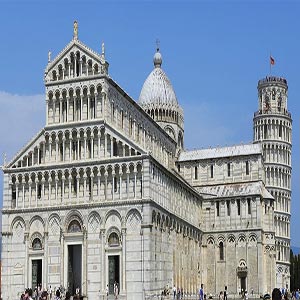Pisa is not just about the Leaning Tower. The city is full of surprises, from the web of narrow medieval alleys to the noble buildings and statuesque cathedrals. Other than the Renaissance heritage, Pisa has influences of Greek culture. Pisa is a popular university town. It boasts of one of the oldest botanical gardens in Europe. Take a car from Genoa or Milan to Pisa. Alternatively you can make use of frequent trains on the Rome Genoa line. International travelers can connect to the city from Galileo airport.
Pisa things to do
Walk to the Piazza delle Vettovaglie in the city center. Stroll through the colorful market square within the elegant 16th century portico. You can the tour of the Lungarni by boat or even choose to go on a one-horse carriage ride. Go across to the Borgo Stretto, perhaps one of Pisa's beautiful streets. Other shopping areas are Corso Italia and Piazza del Miracoli. You can visit Pisa's antique market. You can pick up leather goods, shoes, wooden furniture and terracotta.
Pisa hosts some popular festivals such as The International Festival of Holy Music, Pisa Vini, San Ranieri Historical Regatta and Palio of the Ancient Marine Republic. Volterra is a beautiful festival unique to Pisa when people downtown dress in medieval clothes and the area is decorated much like the medieval times. If you are there in Pisa during Pisa Vini, you can be sure to sample good white and red wines in the Convent of Santa Croce. On the first Sunday of December, there is a colorful Christmas market in the city center. You might be able to pick up interesting bric-a-brac at the antique market held on the first Sunday of each month. If you happen to be in Pisa in May, do not miss the flower festival at Le Piagge.
The Leaning Tower of Pisa
Right from the time of its construction, the Leaning Tower is sinking. It stood straight for the first 5 years when it had just 2 floors. On adding more floors, the tower started inclining. Each year it tilts 1 mm more. This popular monument was designed by Bonanno and was later elaborated upon by Tommaso Andrea di Pisano. Due to its popularity as a leaning monument, most often the architectural splendor of the Leaning Tower is overlooked. It open white galleries and arcades add to the elegance. You can climb up the 294 steps through the inner spiral. With a height of just about 55.86 meters, this is a rather low tower. The Leaning tower of Pisa is located in the Piazza dei Miracoli along with the Duomo Cathedral, the Baptistery and the Camposanto.
Duomo Cathedral Pisa
The Pisa Cathedral has black and white marble inside and boasts of a resplendent gilded ceiling and frescoed dome. Marvel at the magnificently carved pulpit. The exterior of the Duomo is equally interesting. Its stones bear ancient inscriptions and graffiti. The windows have intricate marble mosaic. Often referred to as 'temple of snow-white marble', the cathedral of Pisa bears a Byzantine influence. The dome has the painting of the ascension of the Virgin. The Duomo Cathedral is adorned with artwork that spans various styles. The pulpit is the work of the artist Giovanni Pisano. This imposing structure has a façade of 3540 meters and a height of about 3420 meters. Its elliptical dome was the first of its kind in Europe. Biblical scenes ranging from Immaculate Conception of the Virgin to the road to Calvary and crucifixion of Christ can be seen on the massive 16th-century bronze doors.
The Piazza dei Miracoli
The Piazza del Miracoli dates back to 1648 and has one Europe's oldest Hebrew cemeteries. The Camposanto Monumentale is a cemetery that has many galleries. Many of the frescoes were destroyed during WWII. Literally meaning 'Field of Miracles', this square is a walled section within central Pisa. It was declared a UNESCO World Heritage Site in 1987. It houses stunning pieces of architecture that are a tribute to the craftsmanship and capabilities of the artisans, with magnificent carvings and sculptures.
The Baptistery here is known for its high relief panels and excellent acoustics. It is dedicated to St. John the Baptist. Built entirely in marble, the Baptistery is the largest in Italy. Designed largely in Romanesque and Gothic style, the Baptistery also displays Byzantine influence.
The Church of Santo Stefano and Church of Santa Maria della Spina are built in Gothic style and are worth visiting. Also peek into the Church of San Paolo a Ripa d'Arno or Duomo Vecchio. The Church of Santo Stefano is decorated with panels indicating military exploits. The Church of Santa Maria della Spina is built in rectangular style with black and white marble bands. Find inside famous statues like Madonna of the Rose.
Find the statue of Cosimo I de Medici in the Piazza dei Cavalieri. You can find the Church of Saint Stephen of the Knights here. This church with a marble façade has its ceiling engraved in gold painted wood.


 Rome Italy City Guide
Rome Italy City Guide Capri Italy
Capri Italy Tuscany Italy
Tuscany Italy Verona Italy
Verona Italy Venice Italy
Venice Italy Paola Italy
Paola Italy Amalfi Coast Italy
Amalfi Coast Italy Naples Italy
Naples Italy Sardinia Italy
Sardinia Italy Vicenza Italy
Vicenza Italy Sorrento Italy
Sorrento Italy Aviano Italy
Aviano Italy Gaeta Italy
Gaeta Italy Ravenna Italy Tourism
Ravenna Italy Tourism Vernazza Italy
Vernazza Italy Trieste Tourism
Trieste Tourism Salerno Tourism
Salerno Tourism Things to do in Genoa
Things to do in Genoa Visiting Florence Italy
Visiting Florence Italy Parma Italy Monuments
Parma Italy Monuments Pisa Tourist
Pisa Tourist Assisi Italy
Assisi Italy Pompeii Italy
Pompeii Italy Siena Italy
Siena Italy Sicily Travel
Sicily Travel










